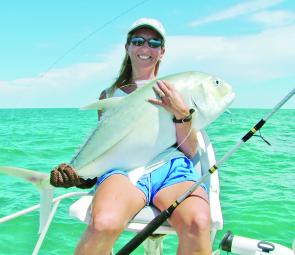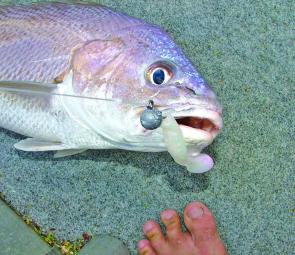Great lure and fly fishing is sure to follow the onset of the wet, especially once the rain has finished and the water has cleared. In t Fish on Parkyn his regard, Karumba will be the perfect place to call in.
January to March is a great time to target barramundi. This time of year can see barra at their most aggressive when they feed on the surface chasing whatever bait is plentiful. They are easily located at the mouths of the drains as the clearer water rushes off the floodplains to meet the river. For those lucky enough to find them, barra may also be targeted while fishing from the beach if the conditions are right. Big barra from the beach is one of the areas great fishing experiences. Watch out for box jellyfish if the rains haven’t come and watch out for crocodiles all the time.
The best giveaway that barra are near is a loud boofing noise. Other clues may be the presence of birds at the drain mouth or even crocodiles. Where there is food the barra will not be far away. Use lures like gold Bombers and Tilsan Barras around the creek mouths. Soft plastics are also a good option flicked up into the drains and slowly bounced out. Big threadfin salmon will be a welcome by-catch in these locations.
March sees pelagics like queenfish and trevally move in around the sand island out near Karumba and there is even a chance of hooking a big fingermark or golden trevally on lures or on a fly if you can locate a school in the deeper water.
From April to June it’s still possible to target barra and king salmon on fly but our attention now shifts to the schools of big queenfish that circle the large sand island at Karumba.
The queenfish, mostly in the early part are only small but make up for this in sheer numbers. Fishing the run-in tide is the best. You can even hop out on the sand and fish from the beach. This has obvious benefits for the beginning fly fisher or kids with plenty of room to swing that arm. Come May and June the quantity of the fish is replaced by quality and the cruisers school up and patrol the seaward edge of the sandbar. Run-out tide is now better as the fish wait for the big schools of garfish to drop off the sand island into the deep water.
This time of year is also the time for Spanish mackerel. By berleying up in the same area as the queenfish are found it is possible to have Spaniards follow the berley behind the boat.
Along with the queenfish and Spaniards, it is also big GT time. Karumba is fortunately (or unfortunately depending on the size of your forearms) blessed with the fact that we don’t seem to get too many small GTs. Most of the fish are big beasts. Even the goldens that sneak in at this time of year are big.
Most of these pelagics are taken trolling lures around the outside of the sand bars at Karumba. There are a few offshore areas that hold rubbly bottom where these fish also congregate. Find the correct bait and the beasts will be there. Good lures for all the species mentioned are big gold Bombers, Halco Scorpions and big bibless minnows like the new Halco Max and Trembler. Trolling garfish is also a tried and tested method.
Jigging metal slices over known holding grounds can be a great way to target the pelagic species with fingermark and black jew also showing a liking for the 40g metal mouthfuls.
Big blue salmon can also provide a welcome change from the beasts and can be targeted in the deeper holes of the rivers on soft plastics and silver or gold metal slices.
July, August and September see a changing of the guard from the pelagics to the blue salmon. This is the time the big fish congregate at the river mouths and these fish definitely pull the kinks out of any fishing line be it on a lure or fly. Fished on the flats on the run in tide or around the wharves at night they give a good account for themselves.
Blue salmon love to hunt in the current where the bait is made helpless. They feed like lunatics and move from place to place hunting by sight. Bigger flies that imitate small garfish or even poppers work well, especially under the lights.
The barra become an option up the creeks once more. Shallow rock bars work particularly well especially in areas where the water drops away to deeper holes either side on the bottom of the tide.
Fingermark in the smaller version seem to head upstream at this time of year possibly following the bait on the big tides and can be taken on lures and fly around snags and in the deeper holes. Do not discount the chance of hooking a black jew on a lure trolled for a barra. Offshore the congregating black jews just love to eat gold and chrome metal slices.
Saratoga are also now an option as access can be gained to the more remote billabongs. Seeking some expert help or local knowledge will assist as saratoga holes are few and far between.
The remainder of the year sees the sport fishing option become more of a challenge due to the build up to the wet season, bringing large tidal flows, north westerly winds and unfavourable offshore conditions. Night fishing under the lights produces well at this time of year. Big king salmon and blue salmon move in following the bait on the run-in tide. Keep your lures small and flies long and slim as most fish this time of year are hunting the gazillion baby garfish that are seeking refuge in the river.
A good clue as to when to try is when you see the small terns working bait up the middle of the river as the tide begins to run in. Big mongrel barra take up residence at the wharves. Target the salmon by anchoring downstream from the wharves and fish the edge of the light. For the barra fish right at the structure and usually closer to the bank and take plenty of spare gear
Around Karumba can be amazingly productive, and if you know when, where and what to use you will increase your chances of a fruitful and enjoyable year of angling.
Reads: 5067
Big GTs are hard work but worth smiling about once you have boated them. One is usually enough for most people.

Black jew love soft plastics given the right conditions. This one came from offshore in the cooler months.




